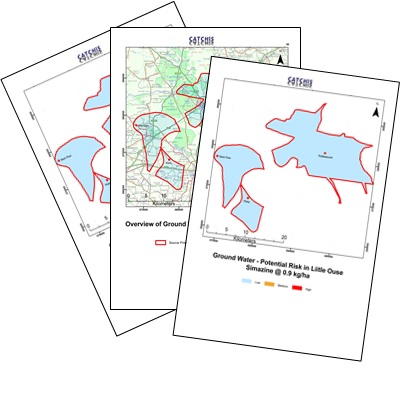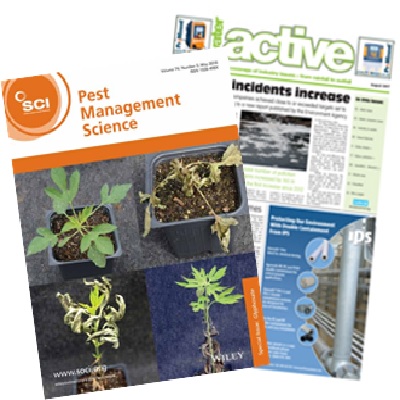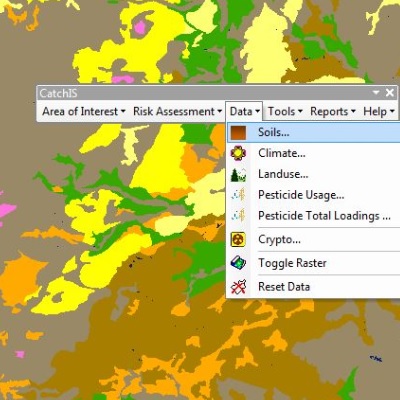CatchIS mission
Integrated water resource management
Since its inception in 1992, Cranfield University's Catchment Information System (CatchIS) aims to provide a toolkit to support and facilitate water resource managers and planners seeking to understand catchment-scale processes and risks. CatchIS is designed to inform those seeking to meet the objectives of the Water Framework Directive and those undertaking Water Safety Plans.
CatchIS development
Piecing CatchIS together
Scientists in the Cranfield Soil and Agrifood Institute (CSAFI) have developed an environmental software suite called CatchIS aimed to assist water resource managers in England and Wales make informative strategic and operational business decisions for cost-effective resource management and investment planning. With dense populations and competing land uses, the interaction of land and water is increasingly important and the ability to manage these complex relationships at the river catchment level is a key aim. This is especially apparent given the requirements of legislative drivers such as the Water Framework Directive, and the need for Water Safetey Plans.
Cranfield University's CSAI scientists have teamed with ADAS UK Ltd to provide, in CatchIS, a comprehensive environmental risk modelling tool focusing on predicting the impact (fate and behaviour) of diffuse pesticide usage on ground and surface waters, giving an accurate statement of the likely future conditions in the catchment. Predictive catchment data on pesticide usage linked to land use and cropping is provided seasonally in autumn and spring to cover the main application periods. These datasets are passed to a suite of simulation models that combine Cranfield's expertise of the fate and behaviour of pesticide compounds in the soil with unique soil, climatological and related environmental datasets detailing catchment conditions. Of particular use to those seeking to manage and forecast the quality of the catchment water resource, CatchIS provides a series of comprehensive mapped and tabular statistical reporting tools.
CatchIS options
CatchIS is offered in two basic configurations: firstly, as a software application and tool (providing the greatest flexibility), and secondly as a bureau service operated for you by Cranfield (offering the greatest ease of adoption).
To supplement these options Cranfield also offers an excellent MSc in Geographical Information Management, which can be taken part-time, focusing on environmental applications for GIS. Further details can be found in the news section. Please contact us to discuss the options below in more detail.
Option A
Provision of CatchIS Software toolkit
CatchIS is a catchment decision-support software tool, in the form of a toolbar within ESRI Inc's GIS product 'ArcMap'. This option is offered inclusive of maintenance and service during the contract period, plus initial training and support. CatchIS operates on a PC running MS Windows and ESRI ArcGIS (ArcView). For further details of the software tool follow the Tour.
Computational requirements
CatchIS will operate on any reasonably powerd laptop or PC running Microsoft Windows 7. Being a graphically and numerically intensive programme, CatchIS benefits from increased RAM.
Where appropriate, CatchIS can also be configured to operate using a centralised fileserver, or a thin-client environment (e.g. Citrix), allowing multiple users of the system to interact with the same data.
CatchIS minimum system requirements are:
- ArcGIS 10.2.2 or later;
- Microsoft Excel;
- Centralised database folder capacity 700 Mb Hard Disk (e.g. network drive);
- Local Install 130 Mb Hard Disk of which 100 Mb should be allocated to your Temporary folder;
- Memory 512 Kb RAM (minimum);
- The CatchIS application has been successfully installed and tested on Windows 7 (running ArcGIS 10.2.2 and Microsoft Excel 2010).
Option B
Provision of CatchIS Bureau Reporting Service
CatchIS can also be offered as a 'Bureau Service' operated for you by Cranfield. This service comprises a series of reports presented in PDF format, consisting of the following:
- A summary report consisting of a broad description of the models and data used, any assumptions made and guidelines on interpreting the results; highlight of key findings; and a glossary of terms.
- Surface water reports for each catchment or water treatment works consisting of seasonal top pesticides, predicted time series and thresholds for the top two pesticides and a hotspots map of the top two pesticides.
- Ground water reports for each source protection zone 3 consisting of seasonal top pesticides and a hotspots map of the top two pesticides.


